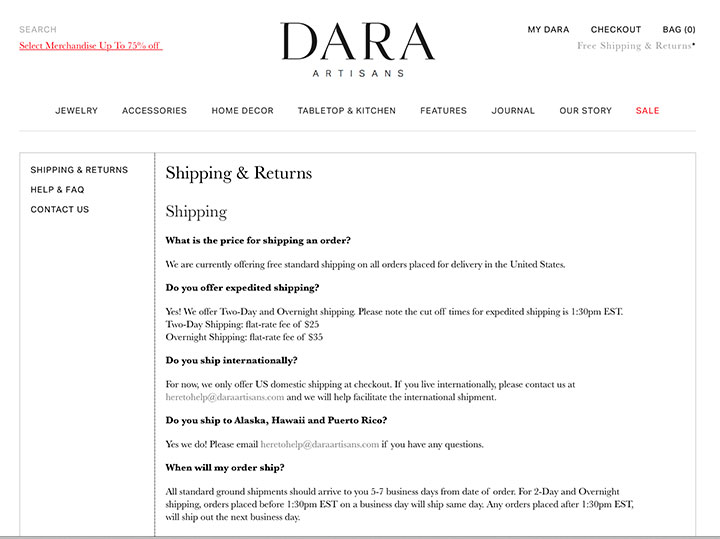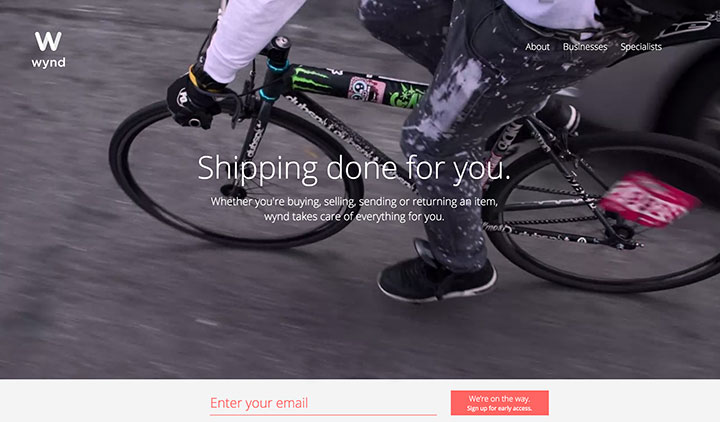10 Savvy Shipping Tips for Ecommerce Retailers
In 2014, the #1 reason for online shopping cart abandonment was shipping. Specifically, having shipping costs beyond expectations caused potential customers to flee, according to a report by BI Intelligence in March 2015.
While typically not the first priority for ecommerce business owners, shipping demands attention. Attractive shipping can increase number of sales and trigger higher order values.
Follow these 10 shipping tips to help your potential customers complete their purchase and become your loyal fans:
1. Make your shipping policy clear
Confusing your website visitors or forcing them to search for your shipping policy is a sure way to annoy them. Potential customers should be able to determine early in the order process if shipping is free or what it may cost. Shopping cart abandonment occurs when the final total cost doesn’t match customer expectations and desires. You risk losing customers if you make them work too hard to figure out total cost or if you surprise them near the end. Your return policy and related shipping costs must also be spelled out clearly as well.

Dara Artisans explains their policies and FAQs on a web page dedicated to shipping.
2. Give buyers options
While most of your customers may be happy with standard shipping, there will be those who want items delivered faster. Don’t stop last minute or eager shoppers from buying from you! Offer expedited shipping to meet their needs. You may also have shoppers who are happy to wait a week for their items and would like to pay as little for shipping as possible. Give them that choice. Shoppers like to have options and exert some control to meet their needs.
3. Profit on products not shipping
We know that free shipping tends to lead to higher order values, especially when you set a free shipping threshold. Even if free shipping is not realistic for your ecommerce shop, shipping is not the place to try to make money. You need to match or beat your competitors’ shipping options if at all possible.
4. Examine the competition
What are your biggest competitors doing? It’s important to know their shipping and fulfillment options so you know how to position your company. Order items from their website (and then return them if desired) and sign up for notifications to hear about special deals on shipping and products.
Once you are clear on the shipping landscape, you can offer better rates and/or services to look more attractive than competitors. If the competition provides free shipping, you may have to see what you can do to match that. If you can’t, see if there are other ways to add value in the order fulfillment process.
5. Give real-time shipping information
To avoid shipping cost surprises, provide real-time shipping information for your potential customers. For example, there are services that can integrate with your Magento or Shopify website to do this. These services calculate what’s in your shopper’s cart and gives customers real time, up-to-date shipping charges based on their shipping destination.
Setting up real time shipping may take a little time to set up—for example, a spreadsheet with physical dimensions of all of your products may be necessary. But once the data is in and systems are in place, your customers will benefit. Real-time shipping prevents cart abandonment since it offers transparency, clarity and accuracy.
6. Offer special shipping options
In some cities there might be special shipping option that can entice potential shoppers. If they want or need the product today, can you get it to them today?
In NYC, we have a company called Wynd who is “dedicated to solving the shipping experience from end-to-end for our customers, no matter what they’re shipping.” Here in the city, ecommerce retailers can create partnerships with Wynd to provide local hand delivery and returns. For example, you can receive your perfectly tailored tie from SKINNYFATTIES at your office in the late afternoon, just in time for that special date.

Wynd offers shipping services locally and globally. Their staff enjoys obsessing over shipping.
7. Compare shipping services and reevaluate them over time
Most savvy ecommerce retailers use a mix of shipping services. This allows them to develop relationships with multiple companies so they can change their shipping mix if prices or customer desires change. What you don’t want to do is just pick one service and stick with it because you don’t want to deal with shipping. This likely means you are losing money on shipping costs unnecessarily.
8. Manage shipping, but don’t actually do the shipping
Many ecommerce retailers outsource their shipping after realizing that managing a significant amount of inventory, warehouses and staff can be a pain. Other retailers continue to fulfill orders in house. Regardless of the model, you, business owner, should not be spending time fulfilling and shipping orders. Your very valuable time and energy should be put on strategic partnerships, marketing and management. Hire someone to focus on shipping details and clear that off your plate.
9. Watch your customer’s experience
No longer does it have to be a mystery how customers react to receiving your product. You can now understand and design the customer experience of opening your shipped package. Thanks to mobile phone video capabilities and services like UserTesting.com, you can ask customers to video the state of the box, the opening of it and their reaction to it. If they have to do any assembly of your product, you can ask them to video that as well. See how Nest Thermostat used mobile video to understand its customer experience. You can do the same for your shipping and fulfillment.

Mobile video user testing allows you to watch the customer experience and hear reactions when people unbox your product.
10. Talk to customers
More ecommerce retailers need to ask customers what they want in terms of shipping. Understanding your target audience helps to make informed decisions on what shipping options are most attractive to them. Your data analytics can give you some information, but you won’t know the “why” of customer decision making on shipping unless you talk with customers.
This can start with a follow up email or survey after a customer receives your products to check for customer satisfaction with shipping. But having direct contact with a human—someone from your company or a hired expert—is better. Conversations with customers on the phone or via Skype or Google hangout can uncover a great amount of information about shipping and other unmet needs or desires.
It may not be glamorous, but smart shipping contributes to the bottom line as well as customer satisfaction. Which tips will you use to improve your shipping situation?
